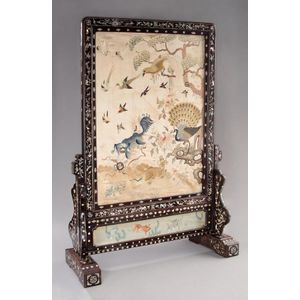Qing Dynasty Silk Embroidered Panel with Exotic Birds and Lions
You must be a subscriber, and be logged in to view price and dealer details.
Subscribe Now to view actual auction price for this item
When you subscribe, you have the option of setting the currency in which to display prices to $Au, $US, $NZ or Stg.
- Mother-Of-Pearl - Mother-of-pearl, technical name "nacre", is the inner layer of a sea shell. The iridescent colours and strength of this material were widely used in the nineteenth century as an inlay in jewellery, furniture, (especially papier mache furniture) and musical instruments.
In the early 1900s it was used to make pearl buttons. Mother-of-pearl is a soft material that is easily cut or engraved.
Nowadays it is a by-product of the oyster, freshwater pearl mussel and abalone industries. - Ming Dynasty - The Ming Dynasty was a ruling dynasty of China from 1368 to 1644. It succeeded the Yuan Dynasty and preceded the Qing Dynasty. The Ming Dynasty was established by Zhu Yuanzhang, a former Buddhist monk who became a rebel leader and eventually overthrew the Mongol Yuan Dynasty. During the Ming Dynasty, China experienced a period of relative stability and prosperity. The government was centralized and bureaucratic, with the emperor at the top of the hierarchy. The Ming Dynasty is known for its cultural achievements, including the development of porcelain, the invention of movable type printing, and the construction of the Great Wall of China.
- Qing Dynasty - The Qing Dynasty was the last imperial dynasty of China, ruling from 1644 to 1912. It was established by the Manchu people, who originated from the northeastern region of China. The Qing Dynasty was preceded by the Ming Dynasty and followed by the Republic of China.
- Foo Dogs - Foo Dogs, also known as "Fo Dogs", "Fu Dogs", and " Buddhist lions" are the Chinese guardian lions that have traditionally stood in front of Chinese Imperial palaces and tombs, government offices, and the homes of the influential are believed to have powerful mythic protective benefits.
They are a popular motif in decorative arts, especially ceramics and garden statuary, where they are depicted in pairs, comprising of a male resting his paw upon an embroidered ball, representing supremacy over the world, and a female restraining a playful cub, representing the nurturing properties of the female.
This item has been included into following indexes:
- Oriental textiles & costume, Chinese
Visually similar items

A late 19th century Chinese rosewood and embroidered silk screen, with mother of pearl inlay frame and stand on foo dog carved feet, the apron with inlay figures, 101 cm height x 71 cm width.

A large Chinese carved wooden table screen with mother-of-pearl inlay, Republic period the screen carved in high relief with a newly-wed couple meeting probably the god of marriage set in a garden landscape, verso with symbols of fortuity and longevity, th

An early 19th century needlework sampler by Jane Flowers, September 1824. Height 43.5 cm. Width 32 cm

A fine gilt-wood plate mirror, English, circa 1680, the frame interspersed with putti, garlands and foliate, 100 x 82 cm
